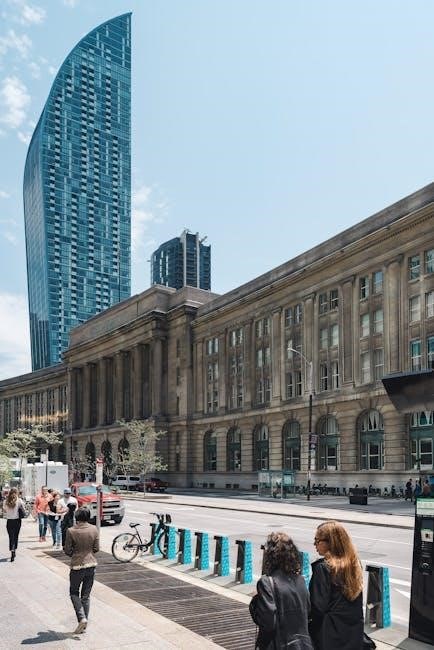ontario building code pdf 2012
The 2012 Ontario Building Code, under the Building Code Act, 1992, promotes public safety, sustainability, and accessibility in construction, with updated standards for design and materials.
Purpose and Scope of the Ontario Building Code 2012
The 2012 Ontario Building Code aims to ensure public safety, health, and accessibility in building construction and occupancy. It sets minimum standards for design, materials, and energy efficiency, promoting sustainable practices. The Code applies to all buildings in Ontario, outlining requirements for fire safety, structural integrity, and accessibility. It also addresses energy conservation, water efficiency, and environmental protection. By providing clear guidelines, the Code helps builders, designers, and regulators comply with legal standards. Regular updates ensure alignment with evolving technologies and societal needs, making it a cornerstone for safe and sustainable development in Ontario.
Key Features of the 2012 Edition
The 2012 Ontario Building Code introduced an objective-based format, emphasizing performance goals alongside prescriptive requirements. This approach allows for innovative solutions while meeting safety standards. Enhanced energy efficiency measures were added, promoting greener buildings. Accessibility standards were strengthened, ensuring equitable access for all. The Code also incorporated new fire safety provisions and updated material standards. Supplementary standards, such as SA-1, SB-1 to SB-13, and SC-1, were introduced to provide detailed technical guidance. These features reflect a commitment to modernizing construction practices, improving safety, and reducing environmental impact, making the 2012 edition a significant advancement in building regulation.

Structure of the Ontario Building Code 2012
The 2012 Ontario Building Code is organized into divisions and sections, offering a clear framework for compliance with regulatory requirements. Its objective-based format enhances understanding and application.
Divisions and Sections Organization

The 2012 Ontario Building Code is structured into clear divisions and sections, ensuring a logical flow of information. It is divided into 12 main parts, each addressing specific aspects of building construction and safety. Part 1 deals with general requirements, while subsequent parts cover topics like building classification, fire protection, and environmental standards. Supplementary standards, such as SA-1, SB-1 to SB-13, and SC-1, provide additional details for compliance. This organization allows users to easily navigate and apply the regulations, ensuring consistency and clarity in construction practices across Ontario.
Objective-Based Format Explained
The 2012 Ontario Building Code introduces an objective-based format, which outlines the underlying goals and sub-objectives of its technical requirements. This approach allows for flexibility in design and construction while ensuring safety, accessibility, and sustainability. By identifying the intent behind each regulation, it enables innovative solutions that meet the specified outcomes. This format is particularly useful for addressing unique building designs and materials, as it focuses on achieving desired performance rather than strictly adhering to prescriptive measures.
For example, fire resistance ratings are tied to specific objectives, such as protecting life and property, while noncombustible materials are required to meet fire safety goals. This structure promotes compliance while encouraging creativity in achieving building standards.

Major Updates in the 2012 Ontario Building Code
The 2012 Ontario Building Code introduced significant updates, including amendments to the Building Code Act, 1992, enhanced energy efficiency requirements, and improved accessibility standards.
Amendments to the Building Code Act, 1992
The 2012 Ontario Building Code includes amendments to the Building Code Act, 1992, enhancing regulatory powers and enforcement. These changes streamline compliance processes, ensuring updated safety standards are met across Ontario. Key updates include expanded inspector authority and stricter penalties for non-compliance, promoting accountability in construction. The amendments also introduce provisions for remote inspections, adapting to modern oversight needs. These revisions reflect a commitment to maintaining public safety and efficiency in building practices throughout the province. The updated Act aligns with evolving construction technologies and methodologies, ensuring Ontario’s building standards remain progressive and effective.
New Requirements for Energy Efficiency
The 2012 Ontario Building Code introduced enhanced energy efficiency standards to reduce energy consumption in buildings. These requirements apply to detached homes, semi-detached homes, townhouses, and small apartment buildings. The code mandates minimum energy performance levels, encouraging the use of energy-efficient materials and systems. For instance, buildings must achieve an EnerGuide rating of 80 or higher. If this target is not met, property owners may need to implement remedial upgrades. These updates aim to promote sustainability and reduce environmental impact while ensuring compliance with modern energy conservation practices. The new requirements align with Ontario’s broader goals of reducing greenhouse gas emissions and promoting eco-friendly construction practices province-wide.
Enhanced Accessibility Standards
The 2012 Ontario Building Code incorporates enhanced accessibility standards to ensure buildings are more inclusive for individuals with disabilities. These requirements include wider doorways, lower countertops, and accessible washrooms. Elevators must have tactile buttons and audible signals, while stairways feature continuous handrails. Parking spaces and ramps are designed to accommodate wheelchairs, with clear signage indicating accessible routes. Emergency systems, such as fire alarms, now include visual and audible alerts for universal accessibility. These updates aim to create barrier-free environments, promoting equality and ease of access for all users. By integrating these standards, the code ensures compliance with accessibility laws and fosters a more inclusive built environment across Ontario.

Technical Requirements in the 2012 Ontario Building Code
The 2012 Ontario Building Code outlines fire resistance ratings, noncombustible material specifications, and structural design standards to ensure safety and durability in construction projects across Ontario.
Fire Resistance Ratings and Exceptions
The 2012 Ontario Building Code provides specific fire resistance ratings for building materials and assemblies to ensure structural integrity during fires. These ratings are determined based on standardized tests and are crucial for maintaining occupant safety. Exceptions to these ratings may apply in certain cases, such as heritage buildings or specific construction types, where alternative fire-safety measures are implemented. The code also outlines exceptions for noncombustible materials, which are exempt from fire-resistance requirements under specific conditions. Compliance with these standards is mandatory to meet the code’s objectives of protecting life and property from fire hazards. Detailed tables and appendices in the code provide further guidance on these requirements and exceptions.
Noncombustible Building Materials
The 2012 Ontario Building Code emphasizes the use of noncombustible materials to enhance fire safety in construction. Noncombustible materials are defined as those that do not ignite or sustain combustion when exposed to fire. These materials are typically required in high-risk areas such as exit stairwells, corridors, and structural components. The code provides specific criteria for identifying and testing noncombustible materials, ensuring they meet stringent fire-performance standards. Exceptions may apply for certain materials under specific conditions, but they must still comply with overall fire-safety objectives. Proper use of noncombustible materials contributes to reducing fire hazards and protecting building occupants. The code’s provisions are designed to balance safety with practical construction practices, ensuring buildings are both safe and functional.
Standards for Building Design and Materials
The 2012 Ontario Building Code establishes detailed standards for building design and materials to ensure safety, sustainability, and accessibility. These standards address structural integrity, fire resistance, and energy efficiency, while promoting the use of durable and environmentally friendly materials. Requirements for insulation, fenestration, and thermal performance are outlined to minimize energy consumption and reduce environmental impact. Additionally, the code includes provisions for material testing and certification to ensure compliance with safety and performance criteria. Design standards also focus on accessibility, mandating features like barrier-free access and adaptable housing. By adhering to these standards, buildings are constructed to withstand various stresses and provide safe, functional spaces for occupants. The code’s material and design requirements are continuously updated to reflect advancements in technology and evolving societal needs.

Supplementary Standards in the 2012 Ontario Building Code
The 2012 Ontario Building Code includes supplementary standards like SA-1, SB-1 to SB-13, and SC-1, which provide additional requirements for specific building elements and safety measures.
Supplementary Standard SA-1
Supplementary Standard SA-1 provides detailed requirements for fire performance, building materials, and energy efficiency, aligning with the 2012 Ontario Building Code’s objective-based format. It includes updates to address emerging construction practices and technologies, ensuring compliance with safety and sustainability goals. Key amendments in 2012 focused on enhancing accessibility and energy conservation, reflecting Ontario’s commitment to modern building standards. SA-1 is integral to the code’s supplementary standards, offering specific guidelines for materials and systems. The standard is available in the 2012 Ontario Building Code PDF, ensuring accessibility for architects, engineers, and builders. Regular updates and clarifications are provided to maintain relevance and effectiveness in the evolving construction landscape.
Supplementary Standards SB-1 to SB-13
Supplementary Standards SB-1 to SB-13 complement the 2012 Ontario Building Code by providing detailed technical specifications for various building components and systems. These standards address topics such as fire safety, structural integrity, and accessibility, ensuring comprehensive compliance with provincial regulations. SB-1 to SB-13 are regularly updated to reflect advances in technology and emerging construction practices, maintaining alignment with the code’s objective-based format. They are essential resources for professionals, offering precise guidelines for materials, design, and installation. The standards are accessible in the 2012 Ontario Building Code PDF, facilitating easy reference for architects, engineers, and contractors. Their implementation supports the code’s goals of public safety, sustainability, and accessibility in Ontario.
Supplementary Standard SC-1
Supplementary Standard SC-1, introduced under the 2012 Ontario Building Code, focuses on fire safety requirements for healthcare facilities, referencing the 2012 edition of the NFPA 99 Health Care Facilities Code. This standard outlines specific guidelines for electrical systems, gas and vacuum systems, and ventilation in healthcare settings to ensure patient and staff safety. SC-1 came into effect on January 1, 2014, as part of the updates to the Building Code, and it is essential for designing and maintaining healthcare facilities in compliance with current safety standards. It provides detailed specifications to mitigate fire hazards and ensure the proper functioning of critical systems, making it a vital resource for healthcare facility construction and renovation in Ontario.

Implementation and Compliance
The 2012 Ontario Building Code ensures compliance through building permits, inspections, and remote inspections for tiny homes and other buildings, promoting adherence to safety and efficiency standards.
Building Permits and Inspections
Building permits are required for new constructions, renovations, or changes in building use to ensure compliance with the 2012 Ontario Building Code. Inspections are conducted at various stages to verify adherence to safety and structural standards. Permits must be obtained before commencing work, and inspections are scheduled upon request. Authorities review plans and conduct site visits to ensure compliance with fire safety, accessibility, and energy efficiency requirements. Remote inspections for buildings, including tiny homes, were introduced in 2022 to streamline the process. Non-compliance can result in penalties, emphasizing the importance of following proper procedures. This system ensures public safety and maintains the integrity of building standards across Ontario.
Remote Inspections for Buildings
Remote inspections for buildings were introduced in 2022 as an amendment to the 2012 Ontario Building Code, enhancing efficiency in the compliance process. This method allows authorities to assess building sites using digital tools, reducing the need for physical visits. Remote inspections are particularly beneficial for monitoring progress in remote locations or during circumstances that limit in-person access. However, they are typically limited to low-risk projects or specific phases of construction. Builders must ensure all documentation and visual evidence meet the required standards for remote evaluation. This innovation supports timely project completion while maintaining safety and compliance with building regulations, aligning with Ontario’s commitment to modernizing construction oversight.
Enforcement and Penalties for Non-Compliance
Enforcement of the 2012 Ontario Building Code is carried out by municipal building officials and inspectors. Penalties for non-compliance include fines, orders to correct violations, or even legal action. The Building Code Act, 1992 empowers authorities to issue orders to enforce compliance, with penalties ranging up to $50,000 for individuals and $100,000 for corporations per offense. Repeat offenses can result in escalating fines. These measures ensure accountability and adherence to safety, accessibility, and energy efficiency standards. Proper enforcement safeguards public health and safety, aligning with the code’s objectives to maintain high construction standards across Ontario.

Accessing the 2012 Ontario Building Code PDF
Download the 2012 Ontario Building Code PDF from the official Ministry of Municipal Affairs and Housing website at www.ontario.ca/buildingcode. Non-commercial use is permitted under specific terms.

Steps to Download the PDF Version
To access the 2012 Ontario Building Code PDF, visit the official website at www.ontario.ca/buildingcode. Follow these steps:
- Navigate to the “Building Code” section on the website.
- Locate the “2012 Building Code Compendium” link.
- Review and accept the terms of use for non-commercial purposes.
- Proceed to download the PDF version free of charge.
- For commercial use, obtain a Ministry-approved licensing agreement.

This ensures compliance with copyright and usage regulations while accessing the document.
Terms of Use for the Digital Compendium
The 2012 Ontario Building Code PDF is available for personal, non-commercial use under specific terms. Users must agree to the Ministry’s licensing agreement for commercial purposes. The digital compendium is protected by copyright, and reproduction or distribution requires authorization. Non-commercial users can access the document free of charge after accepting the terms. Commercial use requires a separate agreement approved by the Ministry of Municipal Affairs and Housing. Ensure compliance with all copyright and usage regulations when accessing or sharing the document. For further details, refer to the official website or contact the Building Code support team.
Contact Information for Further Assistance
For questions or requests regarding the 2012 Ontario Building Code, contact the Ministry of Municipal Affairs and Housing. Visit the official website at www.ontario.ca/buildingcode for detailed resources. You can also reach out via email at [email protected] or call 416-585-6666 for inquiries. For specific guidance on accessing the PDF or licensing, contact the Building Code support team. They provide assistance with compliance, updates, and technical requirements. Always refer to official channels for accurate and up-to-date information to ensure adherence to the Building Code standards.
